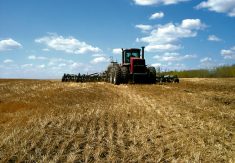CNS Canada — Lingering winter weather across the Prairies means cattle are eating more grain, but the possibility of delayed seeding also means farmers with grain to sell are eyeing better prices.
“As the winter continues to hang on, cattle producers are continuing to have to feed (grain) until they can get their cattle out to pasture,” said Glen Loyns, general manager with JGL Commodities in Moose Jaw, Sask., noting barley markets were seeing some strength as a result.
However, while the demand is there, “farmer participation is not,” he added.
Read Also

U.S. grains: Soy futures post biggest monthly gain in nearly five years on China trade optimism
U.S. soybean futures climbed to a 15-month high and posted their biggest monthly gain in nearly five years on Friday following a rally fueled by the prospect of revived exports to China.
“With the long, extended winter we’re having, guys are just holding onto it for better pricing,” he said, pointing to uncertainty over new-crop production.
“Prices aren’t going down anytime soon.”
Barley in the key feeding area of Lethbridge has moved steadily higher over the past few months, with current bids in the $245-$248 per tonne area, according to government data.
However, additional advances in feed grains may also be hard to come by.
Loyns estimated there was still plenty of unpriced barley in the countryside, despite the aggressive export program this year. Corn imports from the U.S. and Manitoba are another factor keeping a lid on values.
Looking ahead to spring seeding, the solid feed pricing should encourage some acres.
In addition, “as the winter continues to hang on, there’s a higher probability of barley going in the ground because of the shortened growing season,” said Loyns.
While conditions can change quickly at this time of year, he added there were still two feet of snow in some of the northern growing regions.
— Phil Franz-Warkentin writes for Commodity News Service Canada, a Glacier FarmMedia company specializing in grain and commodity market reporting.












